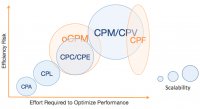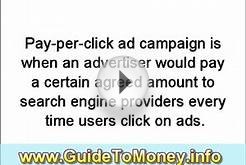 Cost per Click. Cost per Mille. Cost per Action. Cost per Lead. Cost per Engagement…
Cost per Click. Cost per Mille. Cost per Action. Cost per Lead. Cost per Engagement…
Today’s digital advertising is filled with many different pricing options. Just a few decades ago, there only used to be two options: CPC (cost per click) and CPM (cost per 1000 impressions). Now there are dozens.
Pricing options have important implications on advertisers’ budgeting strategy. In this article, we will take a look at what caused the explosion of pricing options, and how advertisers should respond to the complexity.
A Brief History Of Digital Advertising Pricing Models
A carryover from other forms of advertising, the CPM model has existed since the dawn of online advertising, but it first became widespread starting around 1995, when it was adopted by Netscape and Infoseek. DoubleClick, launched in 1996, adopted CPM as its standard pricing model, which was key to popularizing its use in display media.
In 1998, the precursor to the CPC pricing model was pioneered by Goto.com, which later became Overture (and was eventually acquired by Yahoo). Google formally adopted the pricing model in 2002, and CPC has been the standard pricing model for paid search ever since, though it’s also commonly used in display.
The increasing variety of digital media channels in the past decade, along with the improvement of tracking technology, have further expanded pricing options, giving rise to CPE (cost-per-engagement) and CPF (cost-per-follower/fan) for social media, along with CPV (cost-per-view) for internet video, and CPI (cost per app install) for mobile.
 Conversion-based pricing has existed since the past century. However, the increasing focus on performance-based advertising has created newfound interest in CPA (cost-per-action) and CPL (cost-per-lead) models.
Conversion-based pricing has existed since the past century. However, the increasing focus on performance-based advertising has created newfound interest in CPA (cost-per-action) and CPL (cost-per-lead) models.
Nowadays, many publishers offers multiple pricing options, which can be confusing to an advertiser. In order to understand their advantages and disadvantages along with implications on performance, we need to first take a look at the mechanism behind pricing models from a publisher’s perspective.
The Mechanism Behind Pricing Options
Ultimately, all pricing options are translated into a single metric on the publisher side: eCPM, or effective-cost-per-impression (= effective revenue per impression for the publisher. Wherever I mention “cost” below, it is “revenue” from a publisher standpoint).
Let’s say, for simplicity’s sake, that the publisher is interested only in maximizing short-term ad revenue, and the quality of all ads are similar from a user experience perspective. Then the calculation is simple: the publisher will just choose the ad that has the highest eCPM bid.
CPC, CPA, and other types of bids can be translated to an eCPM bid by predicting what the click-through rate (CTR) and conversion rate will be for the ad if it were shown for the particular ad spot:
eCPM = CPC * Predicted CTR * 1000
= CPA * Predicted Conversion Rate * Predicted CTR * 1000
However, this eCPM calculation depends on the accuracy of the CTR and Conversion Rate predictions. The less accurate the prediction, the more risk the publisher will take on that the CTR or Conversion Rate may differ from what was predicted.
Without going into too much detail, it is more difficult to predict events the further along they are in the customer journey, the less frequently they happen, and the more they are influenced by various external factors. Because of this, clicks are relatively easy to predict since they happen frequently, immediately, and on site.
On the other hand, conversions are difficult to predict because they happen less often, after more touchpoints, and are dependent on many different factors. Because of this, CPA pricing is more risky for the publisher compared to CPC pricing, which in turn is riskier than CPM.
For non-auction media, the result is an often-seen and rather straightforward order of preference, where a publisher may first sell as much inventory as possible on a CPM (preferably premium) basis, and then any remnant inventory on a CPC basis, and moves on to CPA (affiliate) sales as a last resort.









